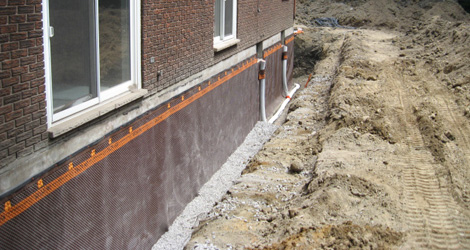Can Weeping Tile Get Clogged?

Weeping tiles are pipes that run around the perimeter of the foundation or inside the basement to help water flow away from these parts. Many older homes also include interior weeping tiles; they are often included in unfinished basements in trenches and work if the exterior tile has failed.
One of the most common ways they fail is through clogs. Yes, they can get clogged, and it can have a huge impact on your entire basement. How does this happen?
How Do Clogs Form In Weeping Tiles?
Despite the name, weeping tiles are porous 4-inch PVC pipes. They have “tile” in the name because builders used terracotta tiles used for drainage solutions before the availability of plastic. Today’s “tiles” are now made of plastic pipes with small slits called weep holes, and they redirect water away from the home.
Even with the change of material, weeping tile drainage systems can become blocked by soil, rocks, and other small debris that gets into the weep holes with the draining water. Plant roots and burrowing animals can also damage the pipe in ways that allow more debris to get in. All this can prevent water from draining away from the foundation fast enough, forcing it against the foundation and causing cracks and leaks that can impact your basement.
How Can I Tell If There’s A Clog In My Weeping Tile System?
One of the most obvious signs of a clog is soggy soil around your home. If your tile isn’t working, it can’t drain the water away, turning the ground very soft with pooling water. Other signs will  show up when the problem becomes worse and affect the inside your basement. Look for horizontal, vertical or diagonal cracks in your basement or crawlspace walls, and look for damp areas or pools of water under basement windows or on the floor. The basement will show signs of mould and mildew on joints and around windows and doors.
show up when the problem becomes worse and affect the inside your basement. Look for horizontal, vertical or diagonal cracks in your basement or crawlspace walls, and look for damp areas or pools of water under basement windows or on the floor. The basement will show signs of mould and mildew on joints and around windows and doors.
The weeping tile system of many homes connects with the sump pump, which sits at the lowest point of the home’s foundation. There’s an easy test any homeowner can do to make sure that water is flowing to the sump pump: run a hose near a spot on the exterior foundation wall – if the sump pump pit fills with water, your tile is working. If not, there’s likely a blockage somewhere in the tiles.
 How Do You Solve Clogged Weeping Tile Systems?
How Do You Solve Clogged Weeping Tile Systems?
Preventing clogs takes regular plumbing checks and maintenance, and it starts with a routine that is good for your entire foundation. Remove leaves and debris from gutters and redirect downspouts away from the house, doing the same for window wells.
There’s also a process known as weeping tile flushing. The technician inserts a line into the weeping tile, sending a high-pressure stream of water through the system to clear out all the debris. It’s not enough for the weeping tile to be clear; make sure your sump pump is working and add a back-up, too.
Before you commit to a solution to your clogged weeping tiles, have an expert come by and assess the situation. Tile flushing isn’t ideal for older systems and can harm already broken systems even further. The problem you’re having with your basement or sump pump may not even be an issue with the weeping tile!
